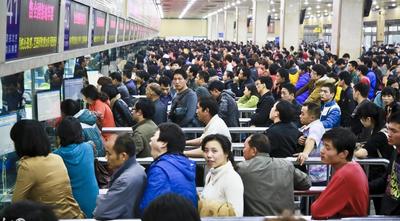|
In a few days' time, on 16 February, 2018, Chinese people around the world will celebrate the Chinese New Year, also known as the Spring Festival. It is the most important festival in China, as families gather together, and friends meet again, after working hard for one year.
In China, hundreds of millions of young people found job opportunities by working in factories or offices in bigger cities. Therefore, every Chinese New Year, they need to travel back to their home provinces, to meet their families and friends. This has created the largest seasonal human migration in the world. In 2017, the Transport Department has recorded 3 billion passengers taking different kinds of public transport (Train, flights, bus, ferries...) in the whole country, for the whole month of Chinese New Year (2 weeks before and 2 weeks after), for people travelling back home before the festival, during the festival, and going back to the cities where they work. Out of which, 4 hundred million passengers took the high speed train system. With the train stations in Canton, Shenzhen, Beijing and Shanghai the busiest, as these are the most developed cities in China, which provide most working opportunities for Chinese people in other provinces. It is expected the the figure will be similar in 2018, with more people travelling on one hand, but change of transport habit on the other, such as people choose to drive back home or use carpool service by Didi Chuxing (The Chinese version of UBER). Even if you are driving, expect to spend at least 3 times on the road, as there are congestion in all major inter-city highways. As a foreigner, it is extremely difficult to travel in China during the Chinese New Year period, as tickets are difficult to get, everywhere is crowed, security is tight at stations ..... So if you planning your next business trip to China, do not come during the Chinese New Year period.
0 Comments
If you travel to big cities in China, it is easy to find bicycles of different colors on the sidewalks and the streets. These are share bicycles from different Chinese companies. Inspired by the car-sharing economy pioneer UBER, the bike-sharing revolution has since transformed the way Chinese people move around the cities, as well as the transport industry as a whole.
Everyday, tens of millions of Chinese people use these share-bikes, which are equipped with GPS and connection to internet. Users just have to download the APP on their mobile phones, and they can find available bikes nearby, open the bike lock through scanning the 2D barcode on the bike body, and pay with their account, all done online, within seconds. Despite the increase popularity and potential of this sharing economy, share bikes have nevertheless caused several problems in the city, such as bikes being dropped off everywhere, increase hazard on road traffic, and stealing of bike parts. Local governments in China and share-bike companies are now working together to reduce the disorder in the cities. For example, users dropping the bikes in designated parking areas will get discounts for their next ride. Now the 2 biggest Chinese companies of share bike, MOBIKE and OFO, have extended their operations to other foreign cities, such as Manchester, Washington D.C., Milan, Florence ... Do you think this share bike idea will succeed like its car-sharing counterparts? |
AuthorMr. Lau, Senior Advisor, Orient+ Archives
December 2023
Categories |













 RSS Feed
RSS Feed